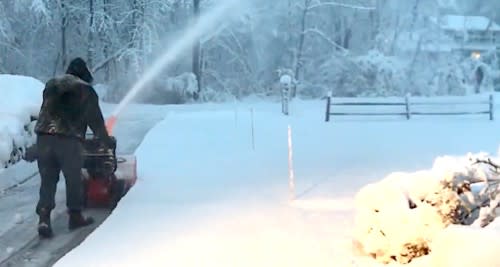Two years ago, more than 50 cm of snow derailed 10 train cars in Ohio

This Day In Weather History is a daily podcast by Chris Mei from The Weather Network, featuring stories about people, communities and events and how weather impacted them.
--
Ohio's first winter storm of the season battered the entire state in early December 2020, with northern sections bearing the brunt of it. The snowbelt areas near Lake Erie had the heaviest and longest-lasting snow, with accumulations exceeding 30 cm -- more than a foot.
The snow began on a Monday, lasting into Tuesday, and that obviously led to widespread problems. It was around 1 p.m. on a normally slow Tuesday when Lorain County, Ohio, was hammered by a winter storm that brought snow and ice. This was the first winter storm of the season for the state, and it was ugly: The opening act was rain but snow headlined the event.

(Mike Picha)
Some impressive snowfall totals were seen in Painesville (57 cm), Edinboro (51 cm), Chesterland (48 cm) and Shaker Heights (43 cm), among other locales.
As a result of the wintry blast, there was a 10-car train derailment in Amherst, Ohio. Five of the cars spilled grain on the tracks, quickly becoming apparent that there was no serious risk of an explosion on the tracks. Fire Chief Jim Wilhelm said no hazardous materials were leaked in this accident but there was quite the mess still.
However, the train’s spillage was not the biggest sigh of relief. The derailed train cars just narrowly missed the main electrical feed that provides power to Amherst's 12,000 residents. The out-of-control train just barely avoided plunging nearby residents into the cold and pitch dark by only about 50 feet (15.24 metres).
A train has derailed in Amherst on 58 overpass near Sliman's. #WhatAMess pic.twitter.com/vwoVfLT839
A train has derailed in Amherst on 58 overpass near Sliman’s. Steve Cawthon on Twitter: "A train has derailed in Amherst on 58 overpass near Sliman's. #WhatAMess pic.twitter.com/vwoVfLT839 / Twitter" Steve Cawthon on Twitter: "A train has derailed in Amherst on 58 overpass near Sliman's. #WhatAMess pic.twitter.com/vwoVfLT839 / Twitter"
— Steve Cawthon (@cawdiddy21) Steve Cawthon on Twitter: "A train has derailed in Amherst on 58 overpass near Sliman's. #WhatAMess pic.twitter.com/vwoVfLT839 / Twitter"
The storm did manage to knock out power to 90,000 customers, however.
How bad could it have been? It was awful, but in a controlled way. The Lorain County Office of Emergency Management and Homeland Security had always been prepared with a response plan in place for such a disaster. There are generators and shelters to keep people warm.
Thankfully, there were no injuries reported, and it was evident from the start that the wintry conditions were the most likely cause behind the derailment.
Geauga County, Ohio...@NWSCLE @ScottSabolFOX8 @JeffTanchak19 @holliesmiles @TrentMWeather @JimCantore pic.twitter.com/Qd5yD4UR98
Geauga County, Ohio...Mike Picha on Twitter: "Geauga County, Ohio...@NWSCLE @ScottSabolFOX8 @JeffTanchak19 @holliesmiles @TrentMWeather @JimCantore pic.twitter.com/Qd5yD4UR98 / Twitter" Mike Picha on Twitter: "Geauga County, Ohio...@NWSCLE @ScottSabolFOX8 @JeffTanchak19 @holliesmiles @TrentMWeather @JimCantore pic.twitter.com/Qd5yD4UR98 / Twitter" Mike Picha on Twitter: "Geauga County, Ohio...@NWSCLE @ScottSabolFOX8 @JeffTanchak19 @holliesmiles @TrentMWeather @JimCantore pic.twitter.com/Qd5yD4UR98 / Twitter" Mike Picha on Twitter: "Geauga County, Ohio...@NWSCLE @ScottSabolFOX8 @JeffTanchak19 @holliesmiles @TrentMWeather @JimCantore pic.twitter.com/Qd5yD4UR98 / Twitter" Mike Picha on Twitter: "Geauga County, Ohio...@NWSCLE @ScottSabolFOX8 @JeffTanchak19 @holliesmiles @TrentMWeather @JimCantore pic.twitter.com/Qd5yD4UR98 / Twitter" Mike Picha on Twitter: "Geauga County, Ohio...@NWSCLE @ScottSabolFOX8 @JeffTanchak19 @holliesmiles @TrentMWeather @JimCantore pic.twitter.com/Qd5yD4UR98 / Twitter" Mike Picha on Twitter: "Geauga County, Ohio...@NWSCLE @ScottSabolFOX8 @JeffTanchak19 @holliesmiles @TrentMWeather @JimCantore pic.twitter.com/Qd5yD4UR98 / Twitter"
— Mike Picha (@themikepicha) Mike Picha on Twitter: "Geauga County, Ohio...@NWSCLE @ScottSabolFOX8 @JeffTanchak19 @holliesmiles @TrentMWeather @JimCantore pic.twitter.com/Qd5yD4UR98 / Twitter"
Repairing the tracks and ties would take days since the snow was so deep it first had to be cleared so removal and restorations could be conducted safely.
To hear more about the, listen to today's episode of "This Day In Weather History."
Subscribe to 'This Day in Weather History': Apple Podcasts | Amazon Alexa | Google Assistant | Spotify | Google Podcasts | iHeartRadio | Overcast'

 Yahoo Movies
Yahoo Movies 
